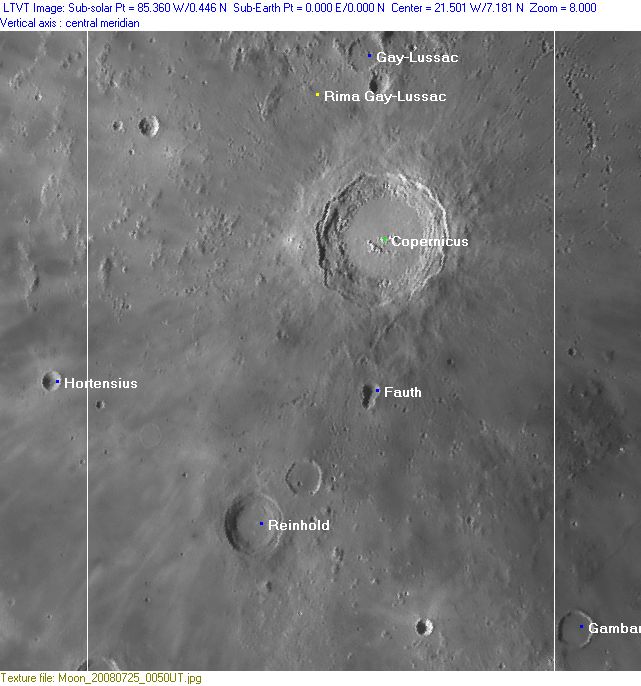Rükl 31
Contents
Rükl Zone 31 - COPERNICUS
Neighboring maps on the Rükl Nearside Map:
| 31 |
||
Photographic Map
(This map is based on an Earth-based photograph that has been computer-corrected to zero libration. The vertical white lines indicate the left and right boundaries of the Rükl rectangle)
Background image source
Named Features
- Apollo 16 S-IVB stage (the fourth of five S-IVB stages which impacted on the moon to show artificially created seismic waves. Apollo 16's S-IVB stage impacted southwest of Reinhold, about halfway between Reinhold and Lansberg) (the impact crater of this S-IVB stage was discovered in 2015 on Narrow Angle Camera photographs made by the Lunar Reconnaissance Orbiter, see article Found! Apollo 16 S-IVB impact crater by Mark Robinson).
- Benavidi (Van Langren's disallowed name for Gay-Lussac Nu) (?) (E.A.Whitaker seems to have been uncertain about that one).
- Carpathian Plateau (an unofficial name for the hilly region west of Copernicus).
- Copernicus (aka The Monarch of the Moon) (Van Langren's Philippi IV) (J.Hewelcke's Mons Aetna, on his Insula Cicilia).
- Copernicus H (a well known dark halo craterlet southeast of Copernicus itself, something quite interesting to observe during Full Moon).
- Eddington (a disallowed name from H.P.Wilkins for Reinhold B, the shallow crater northeast of Reinhold itself).
- Fauth (often nicknamed The Keyhole).
- Gambart hills (an unofficial name for the mountainous regions northwest, west, and southwest of Gambart) (the name Gambart hills was printed on the moonmap of Rand McNally).
- Gay-Lussac
- Insula Anemusa (J.Hewelcke's disallowed name for a bright spot north of Lansberg) (E.A.Whitaker seems to be uncertain about that one).
- Insula Sicilia (J.Hewelcke's disallowed name for the nimbus around Copernicus) (which he called Mons Aetna).
- Insula Ventorum (Riccioli's discontinued name for the region surrounding Copernicus, but wait a minute... so it is depicted on the moonmap made by the Dutch moonobserver A.J.M.Wanders in his moonbook Op Ontdekking in het Maanland (1949), while on Grimaldi's map (the one with Riccioli's nomenclature) it is depicted around... Kepler) (did Wanders mentioned the reason of this change in his book?).
- Lansberg (the partially depicted crater in the lower left corner of chart 31, see chart 42 for most of it).
- Luna 5 (?) (according to Wikipedia, Luna 5 impacted southwest of Copernicus, at approximately 8° North/ 23° West, although the original printed version of Antonin Rukl's atlas shows the impact site of Luna 5 southeast of Lansberg, see Chart 42).
- Mons Cratas (J.Hewelcke's disallowed name for the ejecta ray north of Copernicus, see also Chart 20; the southern part of Mare Imbrium).
- Montes Carpatus (north of Copernicus, see Chart 20).
- Montes Chalcidici (J.Hewelcke's disallowed name for the ejecta ray east of Copernicus).
- Montes Hiblaei (or Hyblei) (J.Hewelcke's disallowed name for the ejecta ray west-southwest of Copernicus).
- Oval Rays (an unofficial name from D.Alter for the curious curved shapes of some of the ejecta rays of Copernicus).
- Reinhold (Van Langren's Mexiae, J.Hewelcke's Mons Neptunus).
- Reinhold Beta (hill south-southeast of Reinhold).
- Reinhold Delta (hill west-southwest of Reinhold) (for the hills Reinhold Beta and Delta, see Chart 53 in the Times Atlas of the Moon).
- Rima Gay-Lussac
- Wagner (a disallowed name from H.P.Wilkins for the crater Tobias Mayer C west-northwest of Copernicus, see Additional Information below; the Wagner case).
Lettered Crater Locations
(click on the thumbnails to display full-sized images; use browser BACK button to return - the dashed white lines are the midpoints of the Rükl zones)
Full zone with lettered craters:
Lettered craters by quadrants:
| North West |
North East |
| South West |
South East |
Additional Information
- Other online descriptions of features in this Rükl map section:
The odd WAGNER case (Tobias Mayer C)
This is a rather strange case, because in Hugh Percy Wilkins's book THE MOON, Section 5, he (H.P.Wilkins) mentioned a certain Wagner who seems to have been a Hanoverian physiologist (Rudolf Wagner 1805-1864), but I think this was some sort of error, because it should have been Johann Wilhelm Wagner (1681-1745); a German astronomer who was active at the observatory of Bernhard Friedrich Freiherr Baron von Krosigk.
It should be mentioned that this astronomer's name (KROSIGK) was once seen at the crater which is nowadays known as Tobias Mayer G.
The astronomers J.W.Wagner and B.v.Krosigk are also mentioned on page 31 of the Dutch moonbook Op Ontdekking in het Maanland, by A.J.M.Wanders (1949).
Discovery of the curious R.Wagner/ J.W.Wagner case (and confusing error in Wilkins's book): Danny Caes (- DannyCaes Sep 19, 2015)





